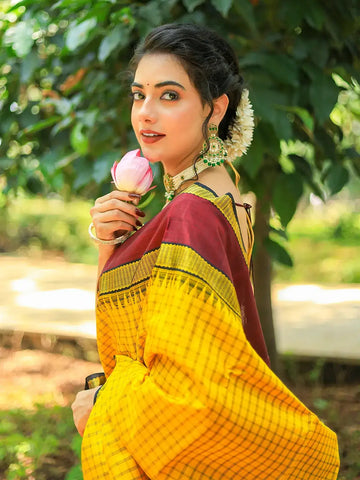
How to Identify a Pure Kanchipuram Silk Saree: Expert Tips and Fabric Checks
Every South Indian bride dreams of that one moment—wrapped in tradition, draped in legacy, glowing in silk. The pure Kanchipuram silk saree is more than just bridal wear; it is a symbol of heritage, a testament to craftsmanship, and a cultural heirloom passed down through generations. But in today’s textile market, where lookalikes are often mistaken for the real deal, identifying a handwoven Kanchipuram saree has become a challenge.

If you're investing in a Kanchipuram saree—whether for your wedding, your daughter's, or simply to honour tradition—you deserve to know what makes a saree truly authentic. This guide walks you through the cultural roots, physical markers, and expert checks to help you choose only the finest.
A Legacy Woven Through Centuries
Kanchipuram, a temple town in Tamil Nadu, has been home to master weavers for over 400 years. These traditional Kanchipuram silk sarees are celebrated for their durability, weight, and richness. Historically worn by royals and temple priests, Kanchipuram sarees often feature motifs like peacocks, lotuses, elephants, and temple towers. The contrast borders, jewel-toned bodies, and gold-dipped zari are deeply rooted in spiritual and ceremonial meaning.
What Truly Makes a Saree ‘Kanchipuram’
Authentic Kanchipuram sarees are made with:
- Pure mulberry silk threads
- Pure zari (silver dipped in gold)
- Korvai technique—body and border woven separately and joined by hand on a loom
The join is an interlock—not stitched or glued. This seamless join is a sign of a genuine handwoven saree.
Zari: The Heart of the Shine
Real zari is crafted from silver and coated in gold. Imitation zari often uses plastic or copper with a metallic finish. Here’s how to check:
- Rub gently—pure zari feels soft; fake zari may flake or feel synthetic
- Look at the shine—pure zari is muted and antique, not overly bright
- Feel the weight—real zari adds significant heaviness to the saree

Feel the Fabric: Texture Never Lies
Pure Kanchipuram silk is crisp, slightly coarse, and holds pleats beautifully. It has a distinct rustle—known as the “silk sound.” Try folding a small section—pure silk may show a faint white crease line under tension. Avoid slippery, glossy, or plasticky textures which signal synthetic blends.
Motifs and Borders: Telling Stories in Thread
All motifs in genuine Kanchipuram sarees are woven, not printed. Some iconic motifs include:
- Peacocks – grace and royalty
- Mangoes (paisleys) – fertility and abundance
- Lotus – purity and spiritual growth
- Checks (kattam) – prosperity and stability
- Temple borders – sacredness and divinity
Look for woven motifs with raised texture and perfect alignment. Faded patterns or printed motifs are signs of mass-produced imitations.
Silk Mark Certification: The Stamp of Purity
The Silk Mark is an official tag issued by the Silk Mark Organisation of India. It guarantees the saree is made of 100% pure natural silk. Always check for this certification, especially when buying online. All Diadem Kanchipuram sarees come with Silk Mark assurance.
Quick Checklist Before You Buy
- Check for korvai join between border and body
- Confirm zari quality (shine, weight, and feel)
- Inspect fabric texture (crisp, not slippery)
- Look for woven—not printed—motifs
- Request Silk Mark certification
Common Myths About Kanchipuram Sarees
-
Myth: Heavier sarees are always authentic
Truth: Some heavy blends use art silk. Real weight comes from zari and silk density. -
Myth: Only red and gold sarees are traditional
Truth: Authentic Kanchipuram sarees come in rich blues, greens, pastels, and dual tones. -
Myth: Shiny sarees are pure silk
Truth: Overly shiny sarees are often synthetic. Pure silk has a soft, elegant glow.
What to Ask Before You Purchase
- Is this saree handloom or machine-made?
- Is the zari pure or imitation?
- Is the border joined with korvai weaving?
- Do you offer Silk Mark certification?
- Can I check the reverse for interlocked weaving and motifs?
Why It Matters
A Kanchipuram saree is more than an outfit. It’s a legacy woven by artisans, a symbol of cultural pride, and a bridal heirloom. Knowing how to identify a genuine one preserves the craft and honors generations of heritage.
At Diadem, we offer only handpicked, certified Kanchipuram silk sarees crafted by traditional weaving families. Each saree is a story—woven in silk, memory, and meaning.
Explore our certified Kanchipuram sarees online or visit our Chennai boutiques for a curated in-store experience tailored to your celebration.
Frequently Asked Questions
-
How can I tell if a saree is pure Kanchipuram silk?
Look for the korvai join, Silk Mark certification, and woven—not printed—motifs. -
What is real zari made of?
Pure zari is made from silver coated in gold, not plastic or copper-based threads. -
Why does Kanchipuram silk feel different from other silks?
It has a crisp, coarse texture and signature rustle that indicates high thread density and authenticity.

